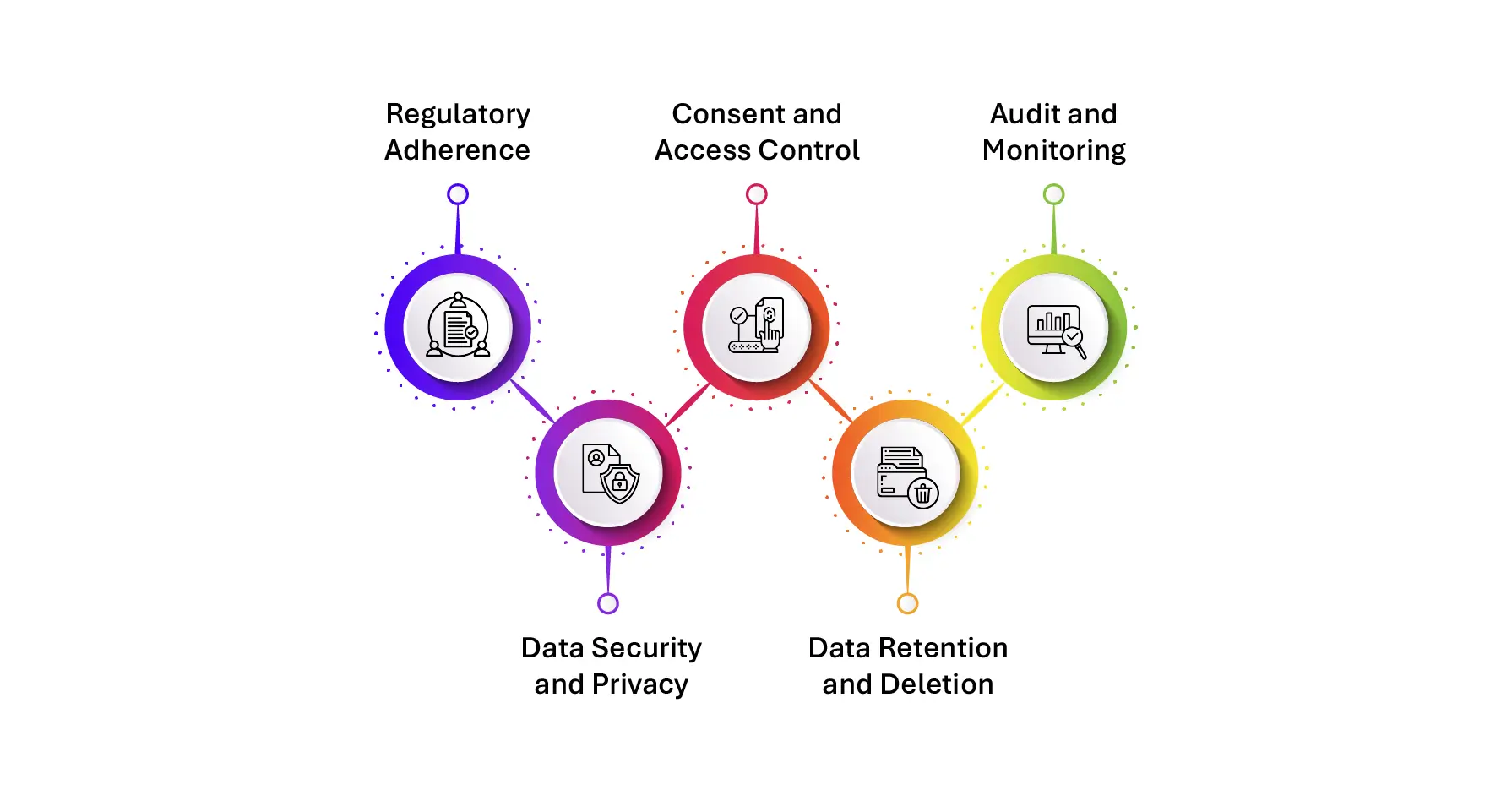What is Data Compliance?
Data compliance refers to the process of ensuring that an organization adheres to relevant laws, regulations, and industry standards that govern the collection, storage, processing, and sharing of data. It is a critical aspect of data governance, ensuring that businesses handle data ethically, securely, and within legal frameworks.
Key Aspects of Data Compliance: A Deep Dive

Regulatory Adherence: Aligning with Global & Industry-Specific Regulations
- Navigating Global & Industry-Specific Compliance – Organizations operating internationally must comply with a maze of regulations, including GDPR in the EU, CCPA in California, PIPL in China, and India’s DPDP Act, ensuring seamless adherence across borders. Industry-specific mandates further complicate compliance, with healthcare governed by HIPAA, finance by SOX, and payments by PCI DSS, requiring businesses to tailor their compliance strategies based on their sector’s unique requirements.
- Data Sovereignty, User Rights & Financial Risks – Data localization laws in countries like China and Russia enforce strict data sovereignty rules, demanding that citizen data be stored within national borders, which directly impacts cloud storage and cross-border data transfers. Additionally, user rights enforcement has become a compliance priority, as regulations like GDPR empower individuals with access, portability, and erasure rights over their data. Failure to comply with these mandates can lead to massive financial penalties, as seen in Amazon’s €887 million GDPR fine and Meta’s $1.3 billion penalty for violating data transfer laws.
- Compliance as a Competitive Advantage & Continuous Adaptation – Companies that proactively integrate compliance into their operations not only avoid legal risks but also gain a competitive edge by fostering customer trust, attracting enterprise clients, and differentiating themselves from non-compliant competitors. With governments continuously updating regulatory frameworks to address emerging risks such as AI governance, businesses must remain agile and adaptable, ensuring their compliance strategies evolve in tandem with new data protection laws.
Data Security & Privacy: Protecting Sensitive Information
- End-to-End Encryption – Encrypting data at rest, in transit, and in use prevents unauthorized access and protects sensitive information from cyber threats.
- Zero Trust Security Architecture (ZTA) – Organizations implement a Zero Trust model where every access request is verified, regardless of whether the user is inside or outside the network.
- Multi-Factor Authentication (MFA) & Role-Based Access – Combining password authentication with biometric scans, security keys, or one-time passcodes adds layers of security, reducing unauthorized access risks.
- Data Masking & Tokenization – Sensitive information, such as credit card numbers and healthcare records, is masked or replaced with tokens to minimize exposure to potential breaches.
- AI-Driven Threat Detection & Response – Machine learning models analyze behavior patterns to identify and mitigate threats in real time, reducing the risk of compliance breaches.
- Automated Data Classification & Sensitivity Labeling – AI-powered solutions categorize data based on sensitivity levels, ensuring appropriate handling and access controls.
Consent & Access Control: Who Can Use Data & How?
- Granular Consent Management – Users must be given clear options to opt in or out of data collection, with easy-to-understand consent forms detailing how their information will be used.
- Role-Based & Attribute-Based Access Control (RBAC & ABAC) – Employees can only access data relevant to their roles, while attribute-based access dynamically adjusts permissions based on factors like location and device security.
- User-Centric Privacy Dashboards – Organizations provide interactive dashboards where users can view, manage, and revoke permissions for data collected about them.
- Biometric & Behavioral Access Controls – Advanced access authentication methods, such as facial recognition and keystroke dynamics, enhance security while ensuring data compliance with privacy laws.
- Minimization of Data Collection – Businesses must justify why specific data points are collected and ensure they only store information that is necessary for operations, reducing regulatory risks.
- Automated Access Reviews & Audits – Companies regularly review and update user access rights, ensuring that employees and third parties only retain access for as long as necessary.
Data Retention & Deletion: When Should Data Be Erased?
- Compliance-Driven Data Retention Policies – Regulations dictate how long businesses can store data, such as GDPR’s requirement that personal data cannot be retained indefinitely without a legal basis.
- Right to Be Forgotten Mechanisms – Organizations must implement processes for users to request the permanent deletion of their data, with legally defined response times for compliance.
- Automated Data Lifecycle Management – AI-powered tools schedule data retention periods, automate deletion for expired data, and ensure compliance with regulatory timelines.
- Data Archiving vs. Deletion Considerations – Some compliance laws allow data to be archived securely rather than deleted, requiring organizations to implement controlled archiving strategies.
- Audit Trails for Deleted Data – When data is removed, businesses must maintain logs proving compliance with deletion requests and demonstrating transparency to regulators.
- Backup & Disaster Recovery Compliance – Even backup copies of data must follow retention policies, ensuring that sensitive data isn’t retained in legacy backups beyond legal limits.
- End-of-Life Data Disposal & Decommissioning – Secure deletion practices, including cryptographic erasure and physical media destruction, ensure that old storage devices don’t become a compliance risk.
Audit & Monitoring: Ensuring Ongoing Compliance
- Real-Time Compliance Monitoring & Alerts – AI-driven monitoring tools track data activities, flagging suspicious access patterns and potential compliance breaches in real time.
- Regular Internal & External Audits – Organizations conduct periodic compliance audits, ensuring that security controls, policies, and data-handling practices align with regulatory requirements.
- Comprehensive Data Governance Frameworks – Establishing governance policies that define data ownership, handling, and accountability ensures regulatory alignment across an organization.
- Automated Compliance Reporting – Businesses use compliance management tools to generate detailed reports that demonstrate adherence to data protection regulations.
- Cross-Departmental Compliance Collaboration – Legal, IT, and compliance teams work together to identify regulatory risks, implement policies, and ensure company-wide alignment with compliance requirements.
- Incident Response & Breach Notification Protocols – Regulations like GDPR mandate that businesses report data breaches within strict timeframes, requiring a well-defined incident response plan.
- Continuous Compliance Training & Awareness Programs – Employees receive ongoing training on regulatory updates, ethical data handling, and security best practices to reduce human errors.
Data compliance is no longer just a regulatory checkbox—it is a strategic imperative that defines trust, security, and business resilience. As global regulations evolve and data privacy expectations rise, organizations must go beyond static policies and embrace AI-driven automation, decentralized governance, and proactive security frameworks. Compliance is no longer just about avoiding penalties; it’s about building a future where data is managed responsibly, ethically, and efficiently. In this era of rapid digital transformation, businesses that prioritize compliance as a core function will not only mitigate risks but also gain a competitive advantage, fostering trust and innovation in an increasingly data-driven world.
Getting Started with Data Dynamics:
- Read the latest blog: The CISO’s New Mandate: Governing Internal Data Policies to Defend Against AI-Powered Threats in 2025
- Learn about our Unstructured Data Management Software – Zubin
- Schedule a demo with our team






